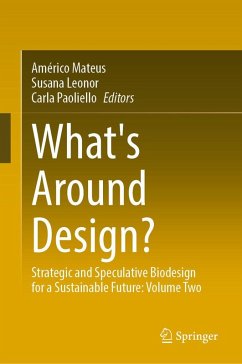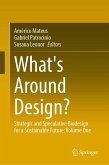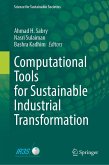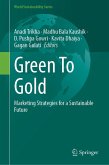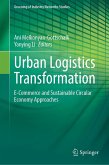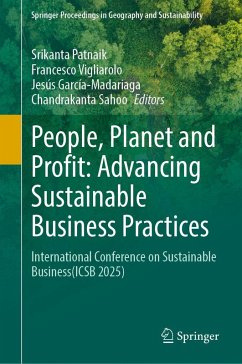What's Around Design?
Strategic and Speculative Biodesign for a Sustainable Future: Volume Two
Herausgegeben:Mateus, Américo; Leonor, Susana; Paoliello, Carla
What's Around Design?
Strategic and Speculative Biodesign for a Sustainable Future: Volume Two
Herausgegeben:Mateus, Américo; Leonor, Susana; Paoliello, Carla
- Gebundenes Buch
- Merkliste
- Auf die Merkliste
- Bewerten Bewerten
- Teilen
- Produkt teilen
- Produkterinnerung
- Produkterinnerung
This book presents volume two of the proceedings of the "What's Around Design?" meeting, held October 2024 in Algarve, Portugal. The chapters here cover a wide variety of topics related to design futures and how design and specifically biodesign can contribute to sustainability. The book's coverage includes but is not limited to biodesign, speculative biofutures, nature-based solutions, and strategic design for green transitions. All chapters in this book were subject to double-blind peer review.
Andere Kunden interessierten sich auch für
![What's Around Design? What's Around Design?]() What's Around Design?136,99 €
What's Around Design?136,99 €![Computational Tools for Sustainable Industrial Transformation Computational Tools for Sustainable Industrial Transformation]() Computational Tools for Sustainable Industrial Transformation119,99 €
Computational Tools for Sustainable Industrial Transformation119,99 €![Aligning ESG goals with the UNs Sustainable Development Goals Planning Aligning ESG goals with the UNs Sustainable Development Goals Planning]() Aligning ESG goals with the UNs Sustainable Development Goals Planning119,99 €
Aligning ESG goals with the UNs Sustainable Development Goals Planning119,99 €![Green To Gold Green To Gold]() Green To Gold106,99 €
Green To Gold106,99 €![Urban Logistics Transformation Urban Logistics Transformation]() Urban Logistics Transformation121,99 €
Urban Logistics Transformation121,99 €![People, Planet and Profit: Advancing Sustainable Business Practices People, Planet and Profit: Advancing Sustainable Business Practices]() People, Planet and Profit: Advancing Sustainable Business Practices136,99 €
People, Planet and Profit: Advancing Sustainable Business Practices136,99 €![Biomimetics, Biodesign and Bionics Biomimetics, Biodesign and Bionics]() Biomimetics, Biodesign and Bionics113,99 €
Biomimetics, Biodesign and Bionics113,99 €-
-
-
This book presents volume two of the proceedings of the "What's Around Design?" meeting, held October 2024 in Algarve, Portugal. The chapters here cover a wide variety of topics related to design futures and how design and specifically biodesign can contribute to sustainability. The book's coverage includes but is not limited to biodesign, speculative biofutures, nature-based solutions, and strategic design for green transitions. All chapters in this book were subject to double-blind peer review.
Produktdetails
- Produktdetails
- Verlag: Springer, Berlin; Springer
- Artikelnr. des Verlages: 89570225
- Erscheinungstermin: 29. Dezember 2025
- Englisch
- Abmessung: 235mm x 155mm
- ISBN-13: 9783032115836
- ISBN-10: 3032115833
- Artikelnr.: 75649471
- Herstellerkennzeichnung
- Springer-Verlag GmbH
- Tiergartenstr. 17
- 69121 Heidelberg
- ProductSafety@springernature.com
- Verlag: Springer, Berlin; Springer
- Artikelnr. des Verlages: 89570225
- Erscheinungstermin: 29. Dezember 2025
- Englisch
- Abmessung: 235mm x 155mm
- ISBN-13: 9783032115836
- ISBN-10: 3032115833
- Artikelnr.: 75649471
- Herstellerkennzeichnung
- Springer-Verlag GmbH
- Tiergartenstr. 17
- 69121 Heidelberg
- ProductSafety@springernature.com
Américo Mateus is Lecturer and Researcher at ISMAT – Lusófona Group, Portimão, and Integrated Senior Researcher at CIAUD – Research Center in Architecture, Urbanism and Design, FAUL – COFAC. His research focuses on Participatory Design, Nature-Based Solutions, Circular Economy, Biodesign, and Innovation, with extensive involvement in European research and innovation projects. He serves as Expert in Taskforce 6 – Co-creation of Nature-Based Solutions of the European Commission and is Director of the Nature-Based Solutions HUB Portugal, appointed by the EU NetworkNature. With more than 60 applied research projects implemented, his work embodies a strong vision of “Science for the Market” and is widely recognized in the fields of design and innovation facilitation. He is a frequent national and international speaker on Design, Creativity, Circularity, Biodesign and Nature-Based Solutions. Currently, he is Senior Researcher in five European projects and Principal Coordinator of the Erasmus+ Project COCOON. Shorter if needed: Américo Mateus is Lecturer and Researcher at ISMAT – Lusófona Group, Portimão, and Senior Researcher at CIAUD–FAUL. His work focuses on Participatory Design, Nature-Based Solutions, Circular Economy, Biodesign and Innovation. He is Expert in Taskforce 6 of the European Commission and Director of the Nature-Based Solutions HUB Portugal (EU NetworkNature). With more than 60 applied research projects, he is recognized as an innovation facilitator and frequent international speaker. He is currently Senior Researcher in five European projects and Coordinator of the Erasmus+ Project Susana Leonor is Professor at ISMAT – Lusófona Group where she directs the Bachelor’s in Communication Design and Creative Technologies. She holds a PhD in Design from the University of Aveiro (2016) and her research focuses on participatory processes, co-design, and pedagogical innovation. She has coordinated and participated in several European projects, including COCOON, EURIDICE, CECAM, and BiomaterialKIT, and in Horizon 2020 projects URBiNAT and Co-Create, where she led tasks on participatory design and co-creation. Her main research interests include Speculative and Critical Design, Biodesign, and sustainable futures. Carla Paoliello is an Assistant Professor at UÉvora, focused on collaboration, traditional practices, eco-consciousness, care, identities, and territory dynamics. She is currently investigating Nature-Centred Design. Graduated in Architecture and Urbanism from the Federal University of Minas Gerais (1995), master's and doctorate in Structural Engineering from UFMG (2001 and 2008), the latter recognised by the Scientific Council of the Faculty of Sciences and Technology of Universidade Nova de Lisboa. Post-doctorate from the University of Lisbon in the Design Section of the Center for Research and Studies in Fine Arts (2015-2016). In 2020, she finished another PhD in Fine Arts at the University of Lisbon, specialising in Product Design.
Microbial biomineralisation in living artefacts for regenerative ecologies:
an overview and design pathways.-The cumatê resin of the amazonian cuias
documentation of an ancestral biomaterial from a biodesign
perspective.-Which label goes on the door navigating the identity of
materials designer.-Biodesigning with living organisms in fablabs towards a
research agenda.-Mapping biodesign at the university of aveiro.-Beyond
temporality ephemeral pavilions and temporary installations as icons of
innovation.-Biofabrication strategies for the recycling of tuscan white
marble by products into innovative bio building materials.-Bio inspired
photobioreactor design harnessing nature for optimal algae
cultivation.-What’s around poliamid hosiery waste.-Circular design and
regenerative design in the transition to a sustainable food
system.-Developing circular based territories by creating meaningful social
urban change through the customer journey framework.- Bioremediation with
heavy metal binding hydrogels and microbial heritage sites.-Conceptualising
the technosphere of a circular economy through a living systems
metaphor.-Reframing design education fostering interdisciplinary learning
through nature inspired and sustainability principles.-Nebulous
narratives.-Sustainable and collaborative restoration with natural
materials of vernacular architecture.-Walking as an interaction design
research tool for exploring urban more-than-human relationships.-Radition
and sustainability importance in education on the fashion field.-Rethinking
service design reconceptualizing complex adaptive systems for sustainable
future.-Strategic design for green transition expanding designers
responsibilities and impact.-Exploring more than human agency in design bio
inclusion in prototyping urban reefs.-The natural resource extraction clock
design strategies for the near future.-Future mill road designing a
more-than human neighbourhood.
an overview and design pathways.-The cumatê resin of the amazonian cuias
documentation of an ancestral biomaterial from a biodesign
perspective.-Which label goes on the door navigating the identity of
materials designer.-Biodesigning with living organisms in fablabs towards a
research agenda.-Mapping biodesign at the university of aveiro.-Beyond
temporality ephemeral pavilions and temporary installations as icons of
innovation.-Biofabrication strategies for the recycling of tuscan white
marble by products into innovative bio building materials.-Bio inspired
photobioreactor design harnessing nature for optimal algae
cultivation.-What’s around poliamid hosiery waste.-Circular design and
regenerative design in the transition to a sustainable food
system.-Developing circular based territories by creating meaningful social
urban change through the customer journey framework.- Bioremediation with
heavy metal binding hydrogels and microbial heritage sites.-Conceptualising
the technosphere of a circular economy through a living systems
metaphor.-Reframing design education fostering interdisciplinary learning
through nature inspired and sustainability principles.-Nebulous
narratives.-Sustainable and collaborative restoration with natural
materials of vernacular architecture.-Walking as an interaction design
research tool for exploring urban more-than-human relationships.-Radition
and sustainability importance in education on the fashion field.-Rethinking
service design reconceptualizing complex adaptive systems for sustainable
future.-Strategic design for green transition expanding designers
responsibilities and impact.-Exploring more than human agency in design bio
inclusion in prototyping urban reefs.-The natural resource extraction clock
design strategies for the near future.-Future mill road designing a
more-than human neighbourhood.
Microbial biomineralisation in living artefacts for regenerative ecologies:
an overview and design pathways.-The cumatê resin of the amazonian cuias
documentation of an ancestral biomaterial from a biodesign
perspective.-Which label goes on the door navigating the identity of
materials designer.-Biodesigning with living organisms in fablabs towards a
research agenda.-Mapping biodesign at the university of aveiro.-Beyond
temporality ephemeral pavilions and temporary installations as icons of
innovation.-Biofabrication strategies for the recycling of tuscan white
marble by products into innovative bio building materials.-Bio inspired
photobioreactor design harnessing nature for optimal algae
cultivation.-What’s around poliamid hosiery waste.-Circular design and
regenerative design in the transition to a sustainable food
system.-Developing circular based territories by creating meaningful social
urban change through the customer journey framework.- Bioremediation with
heavy metal binding hydrogels and microbial heritage sites.-Conceptualising
the technosphere of a circular economy through a living systems
metaphor.-Reframing design education fostering interdisciplinary learning
through nature inspired and sustainability principles.-Nebulous
narratives.-Sustainable and collaborative restoration with natural
materials of vernacular architecture.-Walking as an interaction design
research tool for exploring urban more-than-human relationships.-Radition
and sustainability importance in education on the fashion field.-Rethinking
service design reconceptualizing complex adaptive systems for sustainable
future.-Strategic design for green transition expanding designers
responsibilities and impact.-Exploring more than human agency in design bio
inclusion in prototyping urban reefs.-The natural resource extraction clock
design strategies for the near future.-Future mill road designing a
more-than human neighbourhood.
an overview and design pathways.-The cumatê resin of the amazonian cuias
documentation of an ancestral biomaterial from a biodesign
perspective.-Which label goes on the door navigating the identity of
materials designer.-Biodesigning with living organisms in fablabs towards a
research agenda.-Mapping biodesign at the university of aveiro.-Beyond
temporality ephemeral pavilions and temporary installations as icons of
innovation.-Biofabrication strategies for the recycling of tuscan white
marble by products into innovative bio building materials.-Bio inspired
photobioreactor design harnessing nature for optimal algae
cultivation.-What’s around poliamid hosiery waste.-Circular design and
regenerative design in the transition to a sustainable food
system.-Developing circular based territories by creating meaningful social
urban change through the customer journey framework.- Bioremediation with
heavy metal binding hydrogels and microbial heritage sites.-Conceptualising
the technosphere of a circular economy through a living systems
metaphor.-Reframing design education fostering interdisciplinary learning
through nature inspired and sustainability principles.-Nebulous
narratives.-Sustainable and collaborative restoration with natural
materials of vernacular architecture.-Walking as an interaction design
research tool for exploring urban more-than-human relationships.-Radition
and sustainability importance in education on the fashion field.-Rethinking
service design reconceptualizing complex adaptive systems for sustainable
future.-Strategic design for green transition expanding designers
responsibilities and impact.-Exploring more than human agency in design bio
inclusion in prototyping urban reefs.-The natural resource extraction clock
design strategies for the near future.-Future mill road designing a
more-than human neighbourhood.

